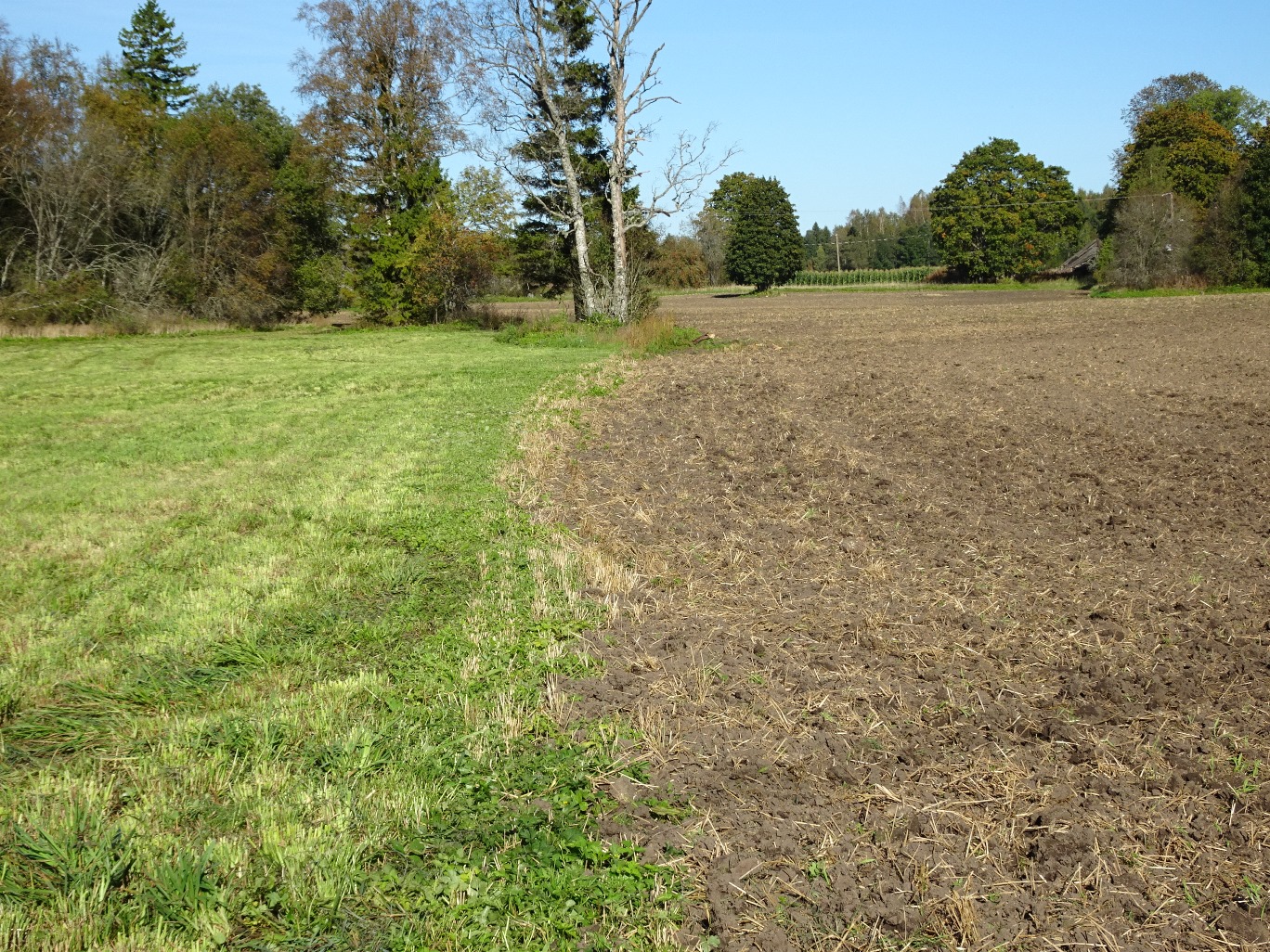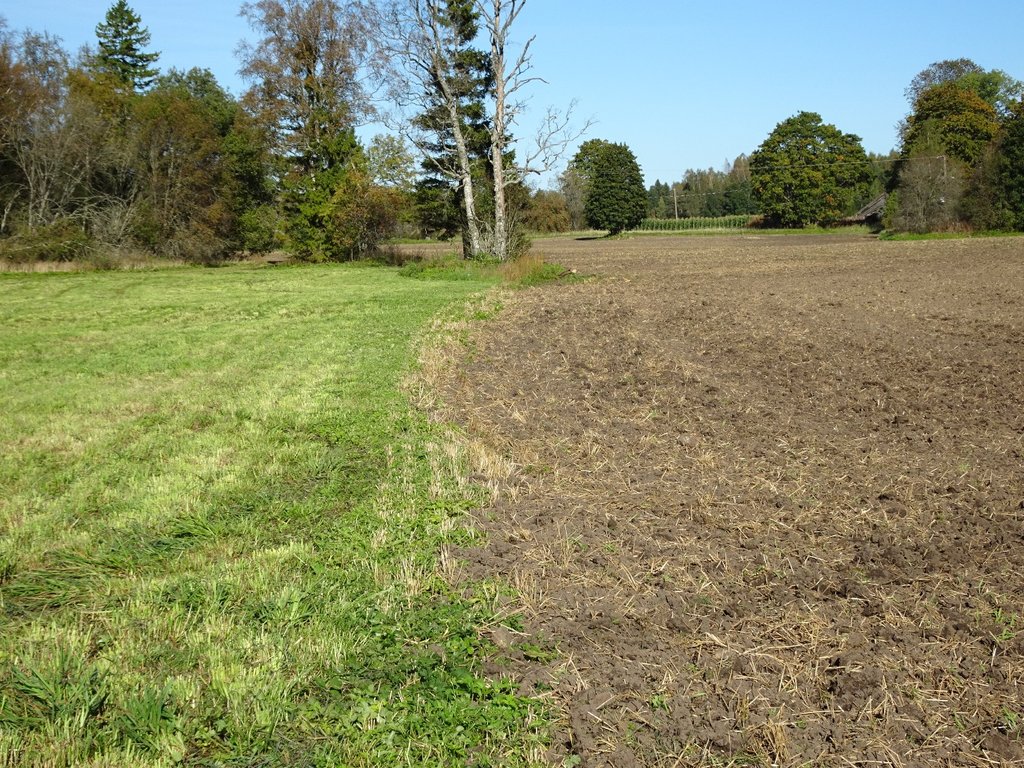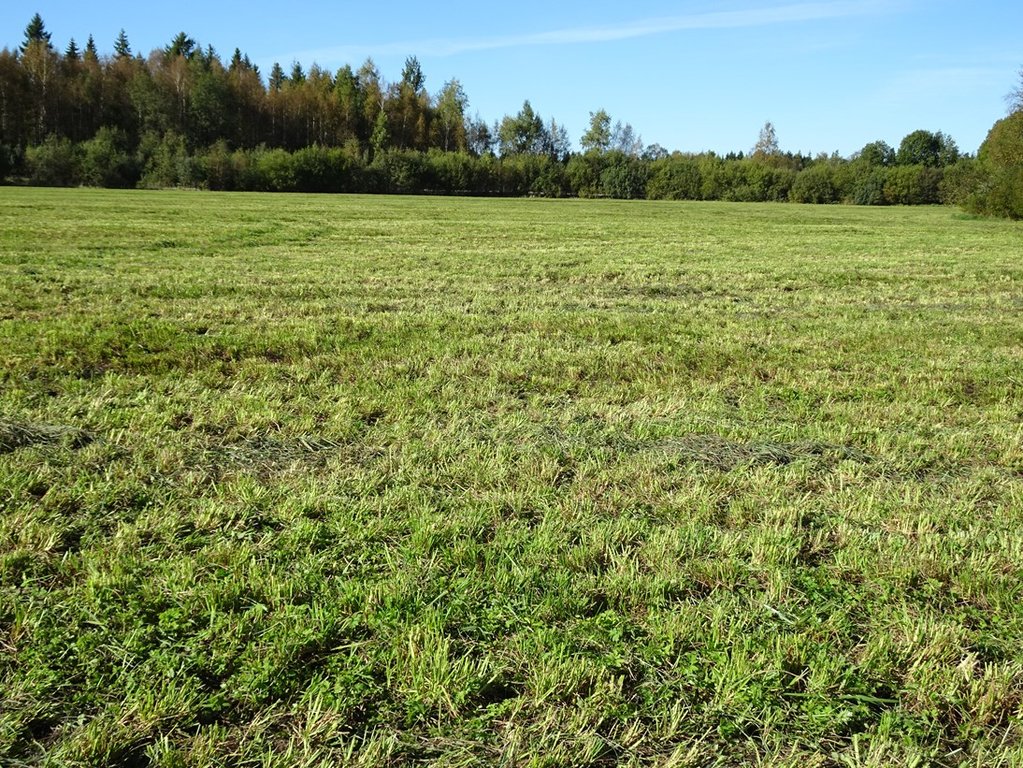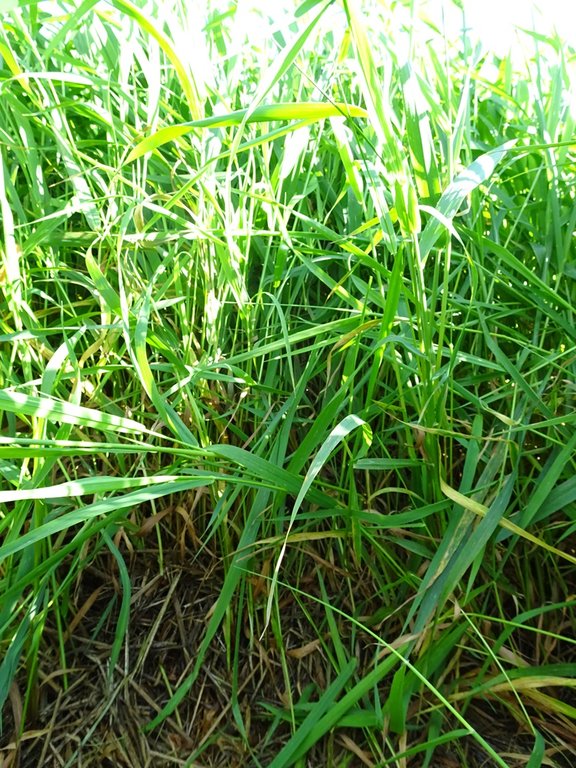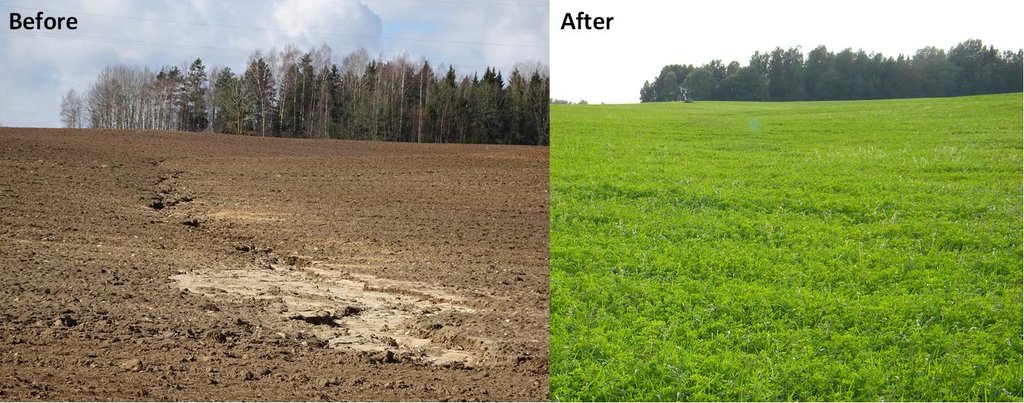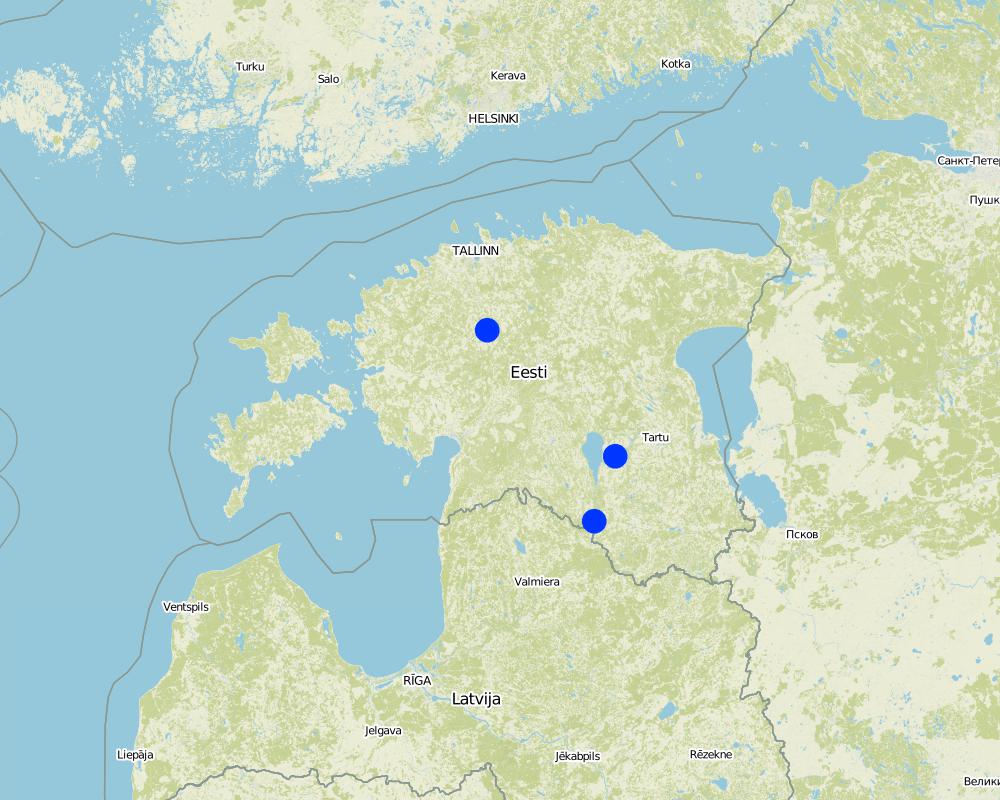Permanent grassland on peaty and eroded soils [Estonie]
- Création :
- Mise à jour :
- Compilateur : Endla Reintam
- Rédacteur : –
- Examinateurs : Ursula Gaemperli, Gudrun Schwilch, Alexandra Gavilano
Püsirohumaa turvas- ja erodeeritud muldadel
technologies_3113 - Estonie
Voir les sections
Développer tout Réduire tout1. Informations générales
1.2 Coordonnées des personnes-ressources et des institutions impliquées dans l'évaluation et la documentation de la Technologie
exploitant des terres:
Selge Are
Hummuli Agro
Estonie
researcher:
Penu Priit
Agricultural Research Centre
Estonie
Nom du projet qui a facilité la documentation/ l'évaluation de la Technologie (si pertinent)
Interactive Soil Quality assessment in Europe and China for Agricultural productivity and Environmental Resilience (EU-iSQAPER)1.3 Conditions relatives à l'utilisation par WOCAT des données documentées
Le compilateur et la(les) personne(s) ressource(s) acceptent les conditions relatives à l'utilisation par WOCAT des données documentées:
Oui
1.4 Déclaration sur la durabilité de la Technologie décrite
Est-ce que la Technologie décrite ici pose problème par rapport à la dégradation des terres, de telle sorte qu'elle ne peut pas être déclarée comme étant une technologie de gestion durable des terres?
Non
2. Description de la Technologie de GDT
2.1 Courte description de la Technologie
Définition de la Technologie:
A permanent plant cover is maintained or established to protect soil against erosion or peat decomposition.
2.2 Description détaillée de la Technologie
Description:
The technology is applied in sub-humid climate with an average of 696 mm of precipitations per year, from which more comes from July to October and less in March and April. Average annual temperature is +4 C, length of the growing period is 180-195 days. The territory is mostly flat to slopes of 6-10%. Average altitude from the sea level is 50 m. About half of the Estonian territory is above 50 m and half is below it. Soils are from very shallow (less than 0.1 m) inthe north to very deep (> 120m ) in the south. Soil cover is very variable. The peat cover of peatlands varies from 0.3 m to more than 10 m from well decomposed to poorly decomposed peat. On hilly areas the soils are medium textured with low (< 1%) organic matter in topsoil. Groundwater in near the surface in peatlands and deep in hilly areas. Biodiversity of these areas is medium. Market orientation of production system is mixed and off-farm income less than 10%. Relative level of wealth is average from individual households to cooperatives. Soil management is mechanized. Land belongs to land users but is leased also in case of bigger farms (over 1000 ha).
In the agricultural land the area will be excluded from intensive tillage by establishing a permanent plant cover, mainly with grass. The aim is to protect the slopes over 10% against erosion and peaty soils from further intensive decomposition of organic matter and with that the reduction of CO2 emission. The farmers should maintain permanent plant cover in the areas mentioned, or establish permanent plant cover. Renewing of the grassland is allowed from the top (without ploughing) once in a 5 year period. Government pays support of 50 EUR/ha if the area is bigger than 0.3 ha. The technology reduces intensively tilled area and thus the possibility to grow cash crops and/or reduces the yield from grassland. On the other hand it allows to still use wet areas for agriculture (i.e. fodder production).
The rules of the technology are fixed with the Estonian Rural Development Plan (ERDP) for 2014-2020 under activity "Support for regional soil protection" (https://www.agri.ee/et/eesmargid-tegevused/eesti-maaelu-arengukava-mak-2014-2020) related to the reguation of the European Parliment and of the Council 1305/2013, article 28. The regulation is relevant more to the South-Estonia in case to reduce erosion, as the landscape is more hilly there. The exclusion of peatlands from agricultural use is relevant more in West-Estonia where the share of peatlands of the total area is the highest. However, it can be applied in whole Estonia if the area of peatland is bigger than 0.3 ha.
2.3 Photos de la Technologie
2.5 Pays/ région/ lieux où la Technologie a été appliquée et qui sont couverts par cette évaluation
Pays:
Estonie
Région/ Etat/ Province:
One site at Rapla, second at Tartu, third at Valga (erosion)
Autres spécifications du lieu:
One site: Rapla county, Pae; second site Tartu county, Annikoru, third site Valga county, Hummuli
Spécifiez la diffusion de la Technologie:
- répartie uniformément sur une zone
S'il n'existe pas d'informations exactes sur la superficie, indiquez les limites approximatives de la zone couverte:
- 1-10 km2
Commentaires:
To get the governmental support the area should be larger than 0.3 ha. Othervise the size is not important, depending on the area covered by hilly area or wet soils in the landscape.
In 2016 it was 10554 ha Histosols and only 40 ha of eroded soils covered with this technology in Estonia. This area excludes grasslands on another soil types. On specific sites: in Rapla county in Pae the size of the field is ca 3.2 ha, at Tartu county, Annikoru 2.8 ha.
Map
×2.6 Date de mise en œuvre de la Technologie
Si l'année précise est inconnue, indiquez la date approximative: :
- il y a entre 10-50 ans
2.7 Introduction de la Technologie
- Governmental tool
Commentaires (type de projet, etc.) :
The tool is a part of Estonian Rural Development Plan (ERDP) for 2014–2020 for soil fertility.
The survey was done by the Soil Survey Bureau of the Estonian Agricultural Research Centre (http://pmk.agri.ee/). The results presented here are partly from this survey and from the work done by the project iSQAPER.
3. Classification de la Technologie de GDT
3.1 Principal(aux) objectif(s) de la Technologie
- réduire, prévenir, restaurer les terres dégradées
- atténuer le changement climatique et ses impacts
3.2 Type(s) actuel(s) d'utilisation des terres, là où la Technologie est appliquée
Les divers types d'utilisation des terres au sein du même unité de terrain: :
Oui
Précisez l'utilisation mixte des terres (cultures/ pâturages/ arbres):
- Agropastoralisme (y compris les systèmes culture-élevage intégrés)

Terres cultivées
- Cultures annuelles
Cultures annuelles - Précisez les cultures:
- céréales - orge
- céréales - maïs
- céréales - avoine
- céréales - seigle
- légumineuses et légumes secs - fèves
- légumineuses et légumes secs - pois
- cultures oléagineuses - tournesol, colza, autres
- plantes à racines et à tubercules - pommes de terre
- légumes - légumes à feuilles (laitues, choux, épinards, autres)
- légumes - légumes-racines (carotte, oignon, betterave, autres)
- wheat
Nombre de période de croissance par an: :
- 1
Précisez:
For the cereals one harvest per year, for grasslands 1-4 cuts per year. For hay 1 cut, for silage 2-4 cuts depending on the year

Pâturages
Pâturage extensif:
- Ranching
Pâturage intensif/ production fourragère :
- Prairies améliorées
Type d'animal:
- bétail - laitier
- bétail - bovins à viande
- ovins
Produits et services:
- viande
- lait
3.3 Est-ce que l’utilisation des terres a changé en raison de la mise en œuvre de la Technologie ?
Est-ce que l’utilisation des terres a changé en raison de la mise en œuvre de la Technologie ?
- Oui (Veuillez remplir les questions ci-après au regard de l’utilisation des terres avant la mise en œuvre de la Technologie)

Terres cultivées
Commentaires:
Usually before the implementation of the technology the land was intensively tilled and used for annual crop plantation. After implementation the grasslands can be used for cutting and grazing.
3.4 Approvisionnement en eau
Approvisionnement en eau des terres sur lesquelles est appliquée la Technologie:
- pluvial
Commentaires:
On Histosols the groundwater is close to the surface.
3.5 Groupe de GDT auquel appartient la Technologie
- Amélioration de la couverture végétale/ du sol
- perturbation minimale du sol
3.6 Mesures de GDT constituant la Technologie

pratiques agronomiques
- A3: Traitement de la couche superficielle du sol

pratiques végétales
- V2: Herbes et plantes herbacées pérennes

modes de gestion
- M1: Changement du type d’utilisation des terres
3.7 Principaux types de dégradation des terres traités par la Technologie

érosion hydrique des sols
- Wt: perte de la couche superficielle des sols (couche arable)/ érosion de surface

érosion éolienne des sols
- Et: perte de la couche superficielle des sols (couche arable)

dégradation chimique des sols
- Cn: baisse de la fertilité des sols et réduction du niveau de matière organique (non causée par l’érosion)

dégradation physique des sols
- Pc: compaction
3.8 Prévention, réduction de la dégradation ou réhabilitation des terres dégradées
Spécifiez l'objectif de la Technologie au regard de la dégradation des terres:
- prévenir la dégradation des terres
- réduire la dégradation des terres
4. Spécifications techniques, activités, intrants et coûts de mise en œuvre
4.1 Dessin technique de la Technologie
Spécifications techniques (associées au dessin technique):
The requirements to create a permanent grassland depends on soil type.
Species mixture suitable for the permanent grassland on wet soils (Histosols): Bromus sitchensis 30%, Phalaris arundinacea 45%, Phleum pratense 20%, Poa pratensis 5%. Sowing rate 20 kg/ha.
For the drier areas (eroded soils) the next mixture is suitable: Dactylis glomerata 65%, Phleum pratense 26%, Poa pratensis 9%. Sowing rate 23 kg/ha.
Auteur:
Endla Reintam
Date:
14/08/2017
4.2 Informations générales sur le calcul des intrants et des coûts
Spécifiez la manière dont les coûts et les intrants ont été calculés:
- par entité de la Technologie
Précisez l'unité:
per hectar
autre/ monnaie nationale (précisez):
EUR
Indiquez le taux de change des USD en devise locale, le cas échéant (p.ex. 1 USD = 79.9 réal brésilien): 1 USD = :
1,18
Indiquez le coût salarial moyen de la main d'œuvre par jour:
36-40 EUR/day + taxes
4.3 Activités de mise en place/ d'établissement
| Activité | Calendrier des activités (saisonnier) | |
|---|---|---|
| 1. | Tillage (ploughing, cultivation) | in spring |
| 2. | Collecting stones, slip (by demand) | in spring |
| 3. | Fertilization | in spring complex fertilizer |
| 4. | Sowing | in spring |
| 5. | Rolling | in spring |
| 6. | Cutting the weeds | during growth (summer) |
| 7. | Fertilization during growth period | after every cut of grass, if cutted grassland, N-fertilizer |
Commentaires:
If renewing the grassland, there will be no ploughing, collecting the stones and sliping. Only chisel plowing and/or sowing with fertilization. If the grassland will be use for grazing, no need for fertilization during growth period.
4.4 Coûts et intrants nécessaires à la mise en place
| Spécifiez les intrants | Unité | Quantité | Coûts par unité | Coût total par intrant | % des coût supporté par les exploitants des terres | |
|---|---|---|---|---|---|---|
| Main d'œuvre | Driver (machinery work) | person day | 0,5 | 36,0 | 18,0 | 100,0 |
| Equipements | Equipment (machinery) cost on establishment year | year | 1,0 | 207,0 | 207,0 | 100,0 |
| Matériel végétal | Seeds | kg | 22,0 | 2,47 | 54,34 | 100,0 |
| Engrais et biocides | Complex fertilizer | kg | 500,0 | 0,42 | 210,0 | 100,0 |
| Engrais et biocides | Ammonium fertilizer | kg | 100,0 | 0,33 | 33,0 | 100,0 |
| Coût total de mise en place de la Technologie | 522,34 | |||||
| Coût total de mise en place de la Technologie en dollars américains (USD) | 442,66 | |||||
Commentaires:
For tillage and other operations it is calculated 14-18 EUR/ha.
If to hire equipment the labour costs should be included to the machinery costs - for cutted grassland 225 EUR/ha, for grazed grassland 162 EUR/ha
4.5 Activités d'entretien/ récurrentes
| Activité | Calendrier/ fréquence | |
|---|---|---|
| 1. | Cutting or grazing the grass | 1-4 times per vegetation period |
| 2. | Fertilization | in spring in the beginning of season and after every cut N-fertilizer, after each second year complex fertilizer |
4.6 Coûts et intrants nécessaires aux activités d'entretien/ récurrentes (par an)
| Spécifiez les intrants | Unité | Quantité | Coûts par unité | Coût total par intrant | % des coût supporté par les exploitants des terres | |
|---|---|---|---|---|---|---|
| Equipements | Grasslands for cutting - machinery costs | year | 1,0 | 141,0 | 141,0 | 100,0 |
| Engrais et biocides | Ammonium fertilizer | kg | 200,0 | 0,33 | 66,0 | 100,0 |
| Engrais et biocides | Complex fertilizer | kg | 200,0 | 0,42 | 84,0 | 100,0 |
| Autre | Materials for hay making | year | 1,0 | 15,0 | 15,0 | 100,0 |
| Coût total d'entretien de la Technologie | 306,0 | |||||
| Coût total d'entretien de la Technologie en dollars américains (USD) | 259,32 | |||||
Commentaires:
The governmental support to establish and to maintain the grassland is 50 EUR/ha.
If to use the land for the grazing, the machinery cost per year is 38 EUR/ha.
4.7 Facteurs les plus importants affectant les coûts
Décrivez les facteurs les plus importants affectant les coûts :
Fuel price.
5. Environnement naturel et humain
5.1 Climat
Précipitations annuelles
- < 250 mm
- 251-500 mm
- 501-750 mm
- 751-1000 mm
- 1001-1500 mm
- 1501-2000 mm
- 2001-3000 mm
- 3001-4000 mm
- > 4000 mm
Spécifiez la pluviométrie moyenne annuelle (si connue), en mm:
696,00
Spécifications/ commentaires sur les précipitations:
Average 696 mm, almost equally spread over the year, more from July to October, less in March and April
Indiquez le nom de la station météorologique de référence considérée:
Tartu Tõravere
Zone agro-climatique
- subhumide
LGP 180-195 days
5.2 Topographie
Pentes moyennes:
- plat (0-2 %)
- faible (3-5%)
- modéré (6-10%)
- onduleux (11-15%)
- vallonné (16-30%)
- raide (31-60%)
- très raide (>60%)
Reliefs:
- plateaux/ plaines
- crêtes
- flancs/ pentes de montagne
- flancs/ pentes de colline
- piémonts/ glacis (bas de pente)
- fonds de vallée/bas-fonds
Zones altitudinales:
- 0-100 m
- 101-500 m
- 501-1000 m
- 1001-1500 m
- 1501-2000 m
- 2001-2500 m
- 2501-3000 m
- 3001-4000 m
- > 4000 m
Indiquez si la Technologie est spécifiquement appliquée dans des:
- situations convexes
5.3 Sols
Profondeur moyenne du sol:
- très superficiel (0-20 cm)
- superficiel (21-50 cm)
- modérément profond (51-80 cm)
- profond (81-120 cm)
- très profond (>120 cm)
Matière organique de la couche arable:
- abondant (>3%)
Si disponible, joignez une description complète du sol ou précisez les informations disponibles, par ex., type de sol, pH/ acidité du sol, capacité d'échange cationique, azote, salinité, etc.
Eutric Histosol, well decomposed peat, drained area.N 2.32%; C32.89%; C/N14.20%; P2,62 mg/100g; K 13.73 mg/100g; Ca 1762.32 mg/100g; Mg 166.98mg/100g
5.4 Disponibilité et qualité de l'eau
Profondeur estimée de l’eau dans le sol:
< 5 m
Disponibilité de l’eau de surface:
bonne
Qualité de l’eau (non traitée):
eau potable
La salinité de l'eau est-elle un problème? :
Non
La zone est-elle inondée?
Non
5.5 Biodiversité
Diversité des espèces:
- moyenne
Diversité des habitats:
- moyenne
Commentaires et précisions supplémentaires sur la biodiversité:
Histosols biodiversity depends on the base saturation and level of groundwater (degree of drainage). Diversity is higher at higher pH and better drainage.
5.6 Caractéristiques des exploitants des terres appliquant la Technologie
Sédentaire ou nomade:
- Sédentaire
Orientation du système de production:
- exploitation mixte (de subsistance/ commerciale)
Revenus hors exploitation:
- moins de 10% de tous les revenus
Niveau relatif de richesse:
- moyen
Individus ou groupes:
- individu/ ménage
- coopérative
Niveau de mécanisation:
- mécanisé/ motorisé
Genre:
- femmes
- hommes
Age des exploitants des terres:
- personnes d'âge moyen
- personnes âgées
5.7 Superficie moyenne des terres utilisées par les exploitants des terres appliquant la Technologie
- < 0,5 ha
- 0,5-1 ha
- 1-2 ha
- 2-5 ha
- 5-15 ha
- 15-50 ha
- 50-100 ha
- 100-500 ha
- 500-1 000 ha
- 1 000-10 000 ha
- > 10 000 ha
Cette superficie est-elle considérée comme de petite, moyenne ou grande dimension (en se référant au contexte local)?
- grande dimension
Commentaires:
There are also small-scale and medium-scale farms applying the technology. At Pae, the farm have 4900 ha of land, from which 1800 are grasslands, at Annikoru the farm have 2320 ha of land from which 390.5 ha are grasslands.
5.8 Propriété foncière, droits d’utilisation des terres et de l'eau
Propriété foncière:
- état
- individu, avec titre de propriété
Droits d’utilisation des terres:
- loué
- individuel
- individual/open access
Commentaires:
Groundwater belongs to the state. Smaller water bodies can be in individual use, larger are usually open access
5.9 Accès aux services et aux infrastructures
santé:
- pauvre
- modéré
- bonne
éducation:
- pauvre
- modéré
- bonne
assistance technique:
- pauvre
- modéré
- bonne
emploi (par ex. hors exploitation):
- pauvre
- modéré
- bonne
marchés:
- pauvre
- modéré
- bonne
énergie:
- pauvre
- modéré
- bonne
routes et transports:
- pauvre
- modéré
- bonne
eau potable et assainissement:
- pauvre
- modéré
- bonne
services financiers:
- pauvre
- modéré
- bonne
6. Impacts et conclusions
6.1 Impacts sur site que la Technologie a montrés
Impacts socio-économiques
Production
production agricole
Commentaires/ spécifiez:
The area will be excluded from crop production and it means no cash crops can be cultivated on this area. Instead of crops hay or silage is possible to sell.
production fourragère
Commentaires/ spécifiez:
As it is not allowed to renew these grasslands intensively, the quantity of grass will drop. For short term clover+grasses mixture the average yield is 16 tons/ha per year, for long-term grass mixtures 5.2 tons/ha per year.
qualité des fourrages
Commentaires/ spécifiez:
Due to the change of species in the mixture, the protein level will drop. Instead of red clover grasses will be used in the mixture of long-term grasslands.
production animale
Commentaires/ spécifiez:
Due to the changes in silage/hay quality (protein) there can be reduction of milk and meat production if the differences will not be covered with other fodder.
diversité des produits
Commentaires/ spécifiez:
In case of crop orientation, there are new products to sell - grass, hay, silage, or grasslands to rent.
gestion des terres
Commentaires/ spécifiez:
Depending on the farm it can be simplified or hindered. If focus was on crops, then new machinery is needed to manage grasslands (for cutting, hay or silage making).
Revenus et coûts
dépenses pour les intrants agricoles
Commentaires/ spécifiez:
As renewing of grassland is after every 5 years, there is no need to buy seeds every year, as well as pesticides and to till the soil.
revenus agricoles
Commentaires/ spécifiez:
Due to the reduction of the inputs costs, the income my increase. Also the government pays support 50 EUR/ha for the land under these measures.
diversité des sources de revenus
Commentaires/ spécifiez:
Next to the yield (grass, silage, hay) the support from the government (50 EUR/ha)
charge de travail
Commentaires/ spécifiez:
It may decrease due to no need of every year tillage and sowing and due to the change from 2 year short-term grasslands to the permanent grasslands. However, if not managed grasslands earlier it may increase the workload as cutting and collecting the grass is needed.
Impacts socioculturels
sécurité alimentaire/ autosuffisance
Commentaires/ spécifiez:
More land under grasslands than under crops. Grasses are suitable for animals feeding, not for human direct consumption.
connaissances sur la GDT/ dégradation des terres
Commentaires/ spécifiez:
If land was eroded before and soil was on the road, everybody can see the differences after establishment of the grasslands. It is not so severe in case of peatlands, however, less tractors will stuck in to the mud on rainy period.
Impacts écologiques
Cycle de l'eau/ ruissellement
ruissellement de surface
Commentaires/ spécifiez:
In case of erosion, no soil will be washed down to the hill as plant cover protects soil surface and increases infiltration. In case of peatlands, grass cover creates better structure and increases water infiltration thus decreases surface runoff during heavy rainfall.
drainage de l'excès d'eau
Commentaires/ spécifiez:
Grass creates protection to the soil surface and raindrops can't destroy the soil structure any more. Also grass roots create better porosity and structure in the soil leading to better water drainage.
Sols
humidité du sol
Commentaires/ spécifiez:
The difference in soil moisture between mineral and organic soils under cereals and under grassland was ca 5% and 25%, respectively, in favour to the grasslands in autumn 2016.
couverture du sol
Quantité avant la GDT:
40%
Quantité après la GDT:
100%
Commentaires/ spécifiez:
Under spring cereals soil is covered only 4-5 months per year, under grasses soil is covered 100% of the year.
perte en sol
Commentaires/ spécifiez:
On the slopes depending o the crop and the amount of precipitations, the loss varied from 3 to 60 tons/ha, under permanent grass cover it is less than 0.05 tons/ha per year. Without every year tillage there is no intensive decomposition of the peat, as well as no wind erosion.
accumulation de sol
Commentaires/ spécifiez:
Under grasses we can increase the soil organic matter content by 0.35 t/ha in 5 year period in peatlands. In eroded soils we can increase 0.02% per year.
encroûtement/ battance du sol
Commentaires/ spécifiez:
As plants protect soil surface, raindrops can't destroy the soil structure and there will be no crust formation
compaction du sol
Commentaires/ spécifiez:
Under the grasslands the bulk density was lower by 0.1-0.2 g/cm3 compared to tilled soil.
cycle/ recharge des éléments nutritifs
Commentaires/ spécifiez:
As the intensive decomposition of the peat stops or there will not be any leaching by water, more nutrients remain in the soil. Also the permanent plant cover during the whole year stops nutrient leaching.
matière organique du sol/ au dessous du sol C
Commentaires/ spécifiez:
Under permanent grasslands the Corg increases by 0.35 t/ha per 5 year period.
acidité
Commentaires/ spécifiez:
Without periodic liming the acidity of peatlands starts to increase. If no CaCO3 in mineral part, also pH of previously eroded soils starts to decrease slowly, as organic acids form during decomposition process.
Biodiversité: végétale, animale
Couverture végétale
Commentaires/ spécifiez:
Thanks to the permanent plant cover there is no period of the year without vegetation.
biomasse/ au dessus du sol C
Commentaires/ spécifiez:
If previously the plant residues were mixed with the soil by tillage, now there will always some extent of plant mass be left above ground (5-10 cm), even if the most is removed for hay or silage.
diversité végétale
Commentaires/ spécifiez:
Long-term grassland includes at least 4 species in the mixture, short-term mixtures 2-3 species. However, compared with the cereals, the annual weeds will disappear and the diversity may decline.
diversité animale
Commentaires/ spécifiez:
There are more spiders, ants, beets.
espèces bénéfiques
Quantité avant la GDT:
2 species of earthworms
Quantité après la GDT:
3-4 species of earthworms
Commentaires/ spécifiez:
Under grasslands were 1-2 more earthworm species than under tilled management. More spiders and ground beetles were found there compared to the tilled soil.
diversité des habitats
Commentaires/ spécifiez:
Grasslands create untilled patterns to the landscape.
contrôle des animaux nuisibles/ maladies
Commentaires/ spécifiez:
Grasses surpress many soil born crops diseases and pests, also annual and perennial weeds.
Réduction des risques de catastrophe et des risques climatiques
impacts de la sécheresse
Commentaires/ spécifiez:
Grass roots go to the deeper soil and they are not so sensitive to the drought.
émissions de carbone et de gaz à effet de serre
Commentaires/ spécifiez:
Under permanent grasslands reduced CO2 emission by 1.10 t/ha per year compared to the tilled areas.
risques d'incendies
Commentaires/ spécifiez:
If the grass will not be cutted before winter, the dry grass has the risk of higher landscape fires in the spring.
microclimat
Commentaires/ spécifiez:
The changes of soil temperature as well as moisture content are smaller under permanent grass cover than under tillage.
6.2 Impacts hors site que la Technologie a montrés
capacité tampon/de filtration
Commentaires/ spécifiez:
All year plant cover helps to bind nutrients and stop their leaching from the soil. Higher amount of organic matter in the soil increases water holding capacity.
sédiments (indésirables) transportés par le vent
Commentaires/ spécifiez:
Organic peat particles are light and are easy subject of wind erosion in dry conditions by tillage. Permanent plant cover stops such kind of erosion
dommages sur les champs voisins
Commentaires/ spécifiez:
On hilly landscape no extra soil is flushed to neighbours fields. In case of peatlands no dust is carried around.
dommages sur les infrastructures publiques/ privées
Commentaires/ spécifiez:
In case of erosion, no soil is carried by water or wind to the ditches and on the roads.
impact des gaz à effet de serre
Commentaires/ spécifiez:
Under permanent grasslands reduced CO2 emission by 1.10 t/ha per year compared to the tilled areas.
6.3 Exposition et sensibilité de la Technologie aux changements progressifs et aux évènements extrêmes/catastrophes liés au climat (telles que perçues par les exploitants des terres)
Changements climatiques progressifs
Changements climatiques progressifs
| Saison | Augmentation ou diminution | Comment la Technologie fait-elle face à cela? | |
|---|---|---|---|
| températures annuelles | augmente | modérément | |
| températures saisonnières | hiver | augmente | modérément |
| températures saisonnières | printemps | augmente | modérément |
| précipitations annuelles | augmente | pas connu | |
| précipitations saisonnières | hiver | augmente | pas connu |
| précipitations saisonnières | automne | augmente | pas connu |
Extrêmes climatiques (catastrophes)
Catastrophes météorologiques
| Comment la Technologie fait-elle face à cela? | |
|---|---|
| pluie torrentielle locale | modérément |
| orage local | pas connu |
| averse de grêle locale | pas connu |
| tempête de neige locale | modérément |
| tempête de vent locale | pas connu |
Catastrophes climatiques
| Comment la Technologie fait-elle face à cela? | |
|---|---|
| vague de froid | pas connu |
| conditions hivernales extrêmes | modérément |
| sécheresse | modérément |
| feu de végétation | pas bien |
Catastrophes hydrologiques
| Comment la Technologie fait-elle face à cela? | |
|---|---|
| inondation générale (rivière) | modérément |
| onde de tempête/ inondation côtière | modérément |
| glissement de terrain | bien |
Catastrophes biologiques
| Comment la Technologie fait-elle face à cela? | |
|---|---|
| maladies épidémiques | bien |
6.4 Analyse coûts-bénéfices
Quels sont les bénéfices comparativement aux coûts de mise en place (du point de vue des exploitants des terres)?
Rentabilité à court terme:
légèrement positive
Rentabilité à long terme:
légèrement positive
Quels sont les bénéfices comparativement aux coûts d'entretien récurrents (du point de vue des exploitants des terres)?
Rentabilité à court terme:
légèrement positive
Rentabilité à long terme:
légèrement positive
6.5 Adoption de la Technologie
- > 50%
Si disponible, quantifiez (nombre de ménages et/ou superficie couverte):
In 2016 two hundred four households got the governmental support, in total 10554 ha
De tous ceux qui ont adopté la Technologie, combien d'entre eux l'ont fait spontanément, à savoir sans recevoir aucune incitation matérielle, ou aucune rémunération? :
- 11-50%
Commentaires:
Anyway, the use of Histosols and Gleysols is limited due to their properties and regular use of these soils is for grazing or grass cutting.
6.6 Adaptation
La Technologie a-t-elle été récemment modifiée pour s'adapter à l'évolution des conditions?
Non
6.7 Points forts/ avantages/ possibilités de la Technologie
| Points forts/ avantages/ possibilités du point de vue de l'exploitant des terres |
|---|
| Better soil protection |
| Possibility to earn money in unsuitable soil conditions. |
| Points forts/ avantages/ possibilités du point de vue du compilateur ou d'une autre personne ressource clé |
|---|
| Reduces soil erosion on hilly landscape |
| Reduces the decomposition of peat on Histosol |
| Reduces CO2 emission from agricultural land. |
6.8 Faiblesses/ inconvénients/ risques de la Technologie et moyens de les surmonter
| Faiblesses/ inconvénients/ risques du point de vue de l’exploitant des terres | Comment peuvent-ils être surmontés? |
|---|---|
| Loss of income | Governmental support (50 EUR/ha) |
| Problems with the grass (farms without animals) | Cooperation with neighbours, selling the hay for energy production |
| Faiblesses/ inconvénients/ risques du point de vue du compilateur ou d'une autre personne ressource clé | Comment peuvent-ils être surmontés? |
|---|---|
| Farmers don't want to use the technology | More effective lobbying |
| Wrong declaration of the land under the technology | Better advisory system and improvement of electronic databases |
7. Références et liens
7.1 Méthodes/ sources d'information
- visites de terrain, enquêtes sur le terrain
5 within iSQAPER project but more than 20 during another projects
- interviews/entretiens avec les exploitants des terres
10 within iSQAPER project but more than 20 during another projects
- compilation à partir de rapports et d'autres documents existants
8
Quand les données ont-elles été compilées (sur le terrain)?
04/06/2017
7.2 Références des publications disponibles
Titre, auteur, année, ISBN:
Bender, A. (koostaja) 2006. Eritüübiliste rohumaade rajamine ja kasutamine. I. ja II. osa. Jõgeva
Titre, auteur, année, ISBN:
Bender, A. 2010. Heintaimede sordiaretus ja seemnekasvatus. Jõgeva Sordiaretuse Instituut
Titre, auteur, année, ISBN:
Older, H. 2011. Kohalikud söödad. Eesti Rohumaade Ühing.
7.3 Liens vers les informations pertinentes en ligne
Titre/ description:
Estonian Rural Development Plan (ERDP) for 2014–2020
URL:
https://www.agri.ee/en/objectives-activities/estonian-rural-development-plan-erdp-2014-2020
Titre/ description:
Kattetulu arvestused taime- ja loomakasvatuses 2016. Koost: Marju Aamisepp, Helle Persitski. Maamajanduse infokeskus. 2017.
URL:
http://www.maainfo.ee/data/trykis/kattetulu/KATTETULU2016.pdf
Titre/ description:
Statistics Estonia
URL:
https://www.stat.ee/en
Titre/ description:
Eesti maaelu arengukava 2007-2013 2. telje ning Eesti maaelu arengukava 2014-2020 4. ja 5. prioriteedi püsihindamiseks 2016. aastal läbiviidud uuringute aruanne. Põllumajandusuuringute keskus. Saku 2016.
URL:
http://pmk.agri.ee/mak/wp-content/uploads/sites/2/2016/09/aruanne_uuringud_2015.pdf
Titre/ description:
Eesti tuleviku kliimastsenaariumid aastani 2100
URL:
https://www.envir.ee/sites/default/files/kliimastsenaariumid_kaur_aruanne_ver190815.pdf
Liens et modules
Développer tout Réduire toutLiens
Aucun lien
Modules
Aucun module trouvé


